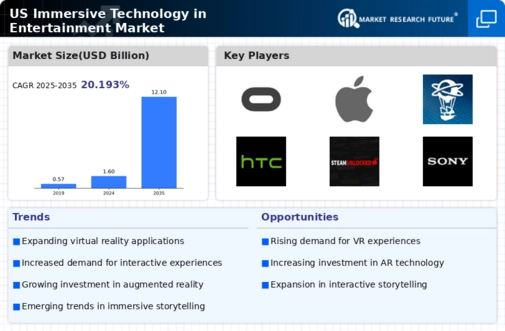Technological Advancements in Hardware
The immersive technology-in-entertainment market is experiencing a surge due to rapid advancements in hardware. Innovations in virtual reality (VR) headsets, augmented reality (AR) devices, and motion tracking systems are enhancing user experiences. For instance, the introduction of high-resolution displays and improved field of view in VR headsets has led to a more engaging and realistic experience. According to recent data, the market for VR headsets alone is projected to reach $12 billion by 2025, indicating a robust growth trajectory. These technological improvements not only attract consumers but also encourage developers to create more sophisticated content, thereby driving the immersive technology-in-entertainment market forward.
Rise of Social and Multiplayer Experiences
The rise of social and multiplayer experiences is significantly influencing the immersive technology-in-entertainment market. As users increasingly seek social interactions within virtual environments, platforms that facilitate multiplayer gaming and social VR experiences are gaining popularity. This trend is evidenced by the growing number of users engaging in online multiplayer games, which has seen a 40% increase in participation over the last year. Companies are responding by developing more collaborative and interactive content, which not only enhances user engagement but also fosters community building. The immersive technology-in-entertainment market is thus likely to expand as these social experiences become more mainstream.
Growing Consumer Demand for Immersive Experiences
Consumer preferences are shifting towards more engaging and interactive forms of entertainment, significantly impacting the immersive technology-in-entertainment market. As audiences seek out unique experiences, the demand for immersive content, such as VR games and AR applications, is on the rise. Recent surveys indicate that approximately 70% of consumers express interest in trying immersive experiences, suggesting a strong market potential. This growing appetite for immersive entertainment is prompting companies to invest in innovative content creation, further propelling the market's expansion. The immersive technology-in-entertainment market is thus positioned to benefit from this evolving consumer landscape.
Expansion of Educational and Training Applications
The immersive technology-in-entertainment market is also benefiting from the expansion of educational and training applications. Institutions are increasingly utilizing VR and AR to create engaging learning environments, which can enhance retention and understanding. For instance, immersive simulations in medical training allow students to practice procedures in a risk-free setting. This trend is not only applicable to education but also extends to corporate training, where immersive experiences can improve employee engagement and skill acquisition. As educational institutions and businesses recognize the value of immersive technology, the market is expected to grow, with estimates suggesting a potential increase in investment by 30% in the coming years.
Integration of Immersive Technology in Traditional Media
The integration of immersive technology into traditional media formats is reshaping the entertainment landscape. Film and television industries are increasingly adopting VR and AR elements to enhance storytelling and viewer engagement. For example, immersive documentaries and interactive films are gaining traction, allowing audiences to experience narratives in novel ways. This trend is reflected in the increasing number of partnerships between tech companies and media producers, aimed at developing immersive content. The immersive technology-in-entertainment market is likely to see substantial growth as these collaborations become more prevalent, with projections suggesting a potential increase in market value by 25% over the next five years.

















Leave a Comment